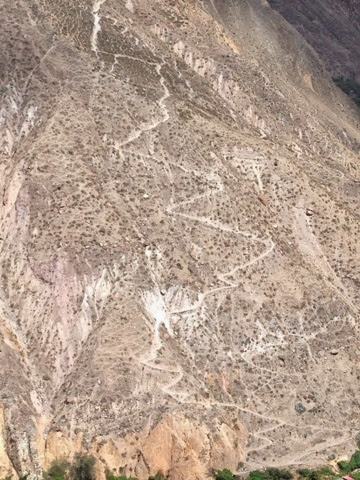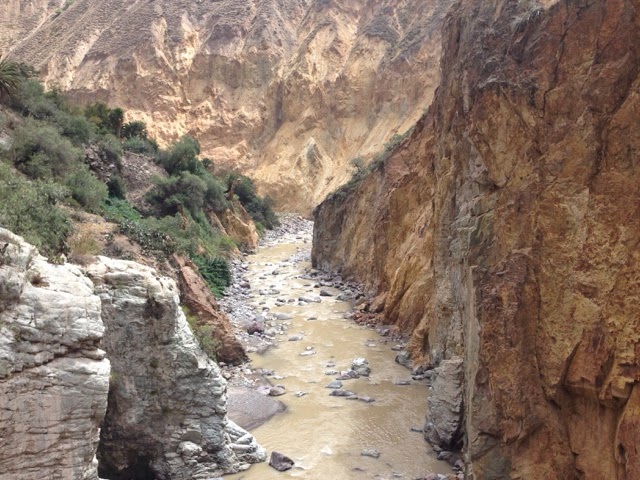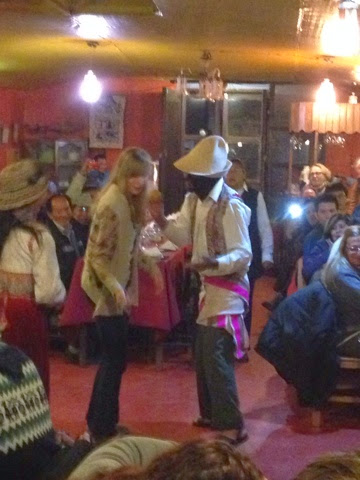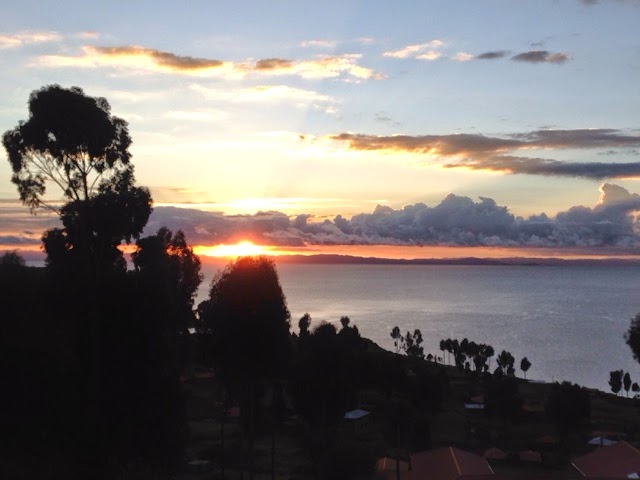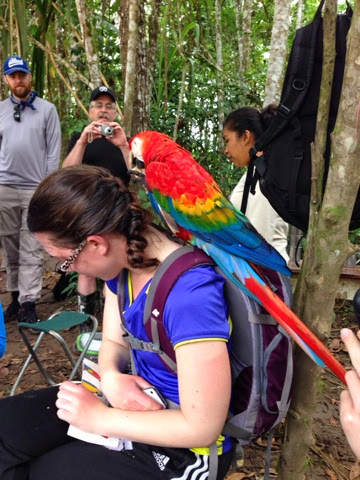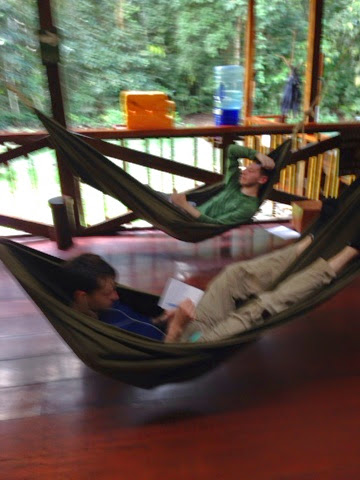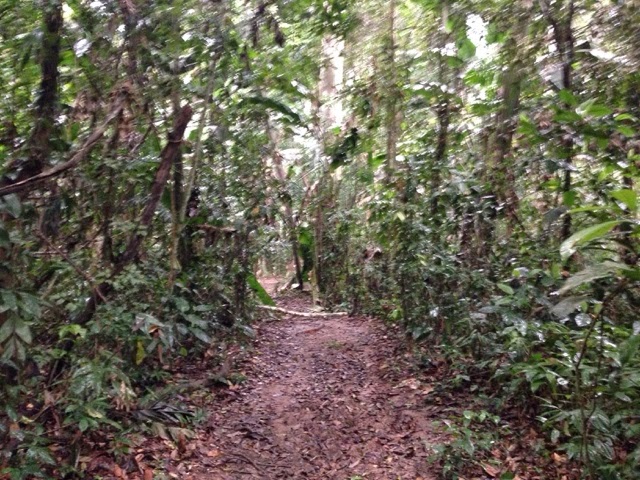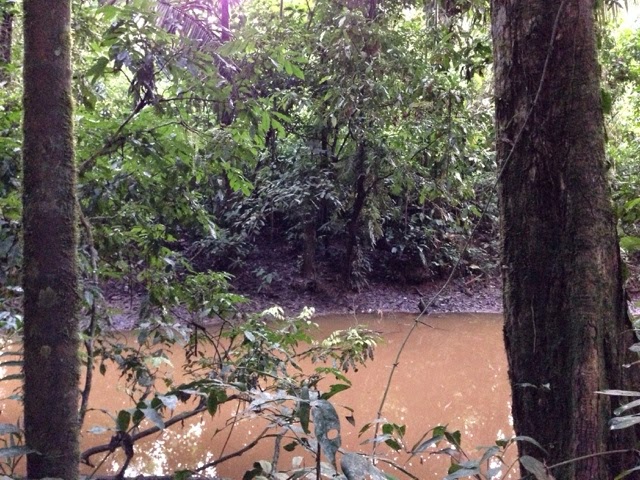This blog describes the travels of a class from Elmira College which is journeying through Peru. We are studying how differences in geography and environment can contribute to regional differences in economic development. We are also studying the link between the environment and sustainable development. Our itinerary will take us from the highlands of the Andes to the lowlands of the Amazon; from islands in Lake Titicaca to an oasis in Colca Canyon. We hope you enjoy our discoveries.
Wednesday, April 30, 2014
April 29th - Colca Canyon Day 2
Our second day in the canyon began with a visit to two more families in the community to deliver more of the supplies we had brought for them. We then had a delicious breakfast of crepes with sliced bananas and chocolate and caramel sauce drizzled on top (who would have thought?).
Before leaving the village where we had stayed overnight we stopped at the primary school and were fortunate enough to see class in session. We gave them the games we had brought for them and took some pictures. The school only had two children because so many families have moved out of the village to the bigger towns outside the canyon. Pablo told us that there were only ten families left and the teacher was worried that he would soon lose his job because the goverenment would close the school. To attend secondary school the kids would have to walk to the top of the canyon to the village of Cabanaconde and then come back down again every day - a six hour hike! This is another reason why many families chose to leave the canyon.
We then started the second day of our hike. Our destination for the day was the village of Sangalle, which is an oasis at the bottom of the canyon where there was the promise of a pool and lush greenery to provide relief from the dry, desert like climate of the canyon. As we hiked, Pablo stopped on numerous occasions to pick fruit for us to try from the groves of fruit trees we passed along the way. We got to try pears and cactus fruit and something that looked like kiwi but was very sour and lemony.
The lower part of the canyon was green and lush with avocado, apple, lemon, fig, pomegranate and all sorts of fruit trees. Unfortunately transporting this bounty to the top of the canyon and to market to sell was so difficult that the villagers couldn't use the harvest for income. Instead they consumed it themselves and used it to barter amongst each other.
We hiked steadily for about two and a half hours and then came to a point where we could see the oasis down below. That motivated everyone and we practically flew down the canyon to get there, although it took another hour to actually reach our lodgings. Most of the students went right to the pool; I took advantage of some hammocks to rest after the hike.
After a late lunch we then had the entire rest of the day free, something that hasn't happened yet during our travels. Students rested, wrote in their journals and talked. Then a couple of the guides set up a volleyball net and we played volleyball for close to two hours. I had never played volleyball before and have concluded that it is a decidedly painful game; my forearms and hands are still sore. The fact that I was probably not hitting the ball correctly might have something to do with it. The students however had a blast and as always became competitive with some good natured taunts being thrown on both sides. I think they've really enjoyed this day; I'll get some feedback from them over dinner which we are waiting for.
After dinner it will be early bedtime because we are to leave at 5 a.m. to begin the climb out of the canyon. Pablo has shown us the zigzag path that will lead all the way up and it looks intimidating. The students are preparing themselves for a tough hike tomorrow. Buenes suerte (good luck) to us!
April 28th - Condors and Hiking Down Colca Canyon
Today has been a long day, even in the realm of all the long days we've had. The students have held up beautifully despite the early hours and long days.
We had a 5:30 a.m. departure to go to Cruz del Condor. This is the spot where people go to watch condors take off from the canyon floor where they catch thermal currents and circle around higher and higher until they fly off to hunt for food. Pablo gave us some facts about condors as we drove to the crossing. They are part of the vulture family and only feed on carcasses. They are endangered because the local people used to fear them thinking they would prey on livestock and children so they were hunted by them. They are also suffering from a reduction in their food supply adding to their dwindling numbers. Condors are one of the largest birds in the world (technically the albatross has a longer wingspan of 4m although it weighs only 8 kg), with a wingspan of 2.5-3 m and weighing up to 15 kg. They usually build their nests in the highest peaks at 5000m or more and live from 65-100 years.
We got to Cruz del Condor ahead of the crowds and for the first hour saw a handful of condors from a distance rising up from the canyon floor. All of a sudden dozens of condors started flying a few meters in front of and above us and we had a chance to really observe them up close. A couple of them flew down and perched on a rock right in front of us and we really got to see their faces; the resemblance to vultures was astonishing. They seemed to glide around effortlessly and their black and white coloring was so striking to watch. Truly an awesome sight.
As we passed the valleys we noticed the same system of agricultural terracing we
had seen in the Andes. Pablo told us that the terraces date back to pre-Inca times although the Incad refined the system and were able to grow more variety at higher altitudes. We also learned that people in the valley practice the Inca system of mita where each families take turns helping one another with the agricultural work.
After the condor crossing it was time to get to the starting point of our trek down Colca Canyon. The canyon was steep, rocky, and dusty and by now the sun was pretty strong so it was blazing hot as well. The three hour hike down was brutal for me but the students seemed to leap down the trail like mountain goats. At the bottom of the canyon we came to a bridge which then led to an uphill climb to our stop for the day where we also got lunch. I arrived at that stop a good hour behind the students and they had been amusing themselves by playing cards. Lunch was wolfed down by all of us, ruined only by the fact that we later found out that the meat we had eaten
was baby llama : (
After a brief rest we then walked further down the trail to the home of a local family. This was a very poor family that Pablo had set up a visit with. In Chivay we had bought some staples like rice,
pasta, oil and sugar to give to three families in the valley. Pablo had also brought some onions, lettuce and beets to plant.
First we had to till the ground which we did with hand held hoes, one of which Pablo had brought along and the others the family had. The students all took turns at the hoe although Kurt and Pablo did the brunt of the work. While they tilled the ground the rest of us pulled weeds to clear the ground while a couple of us prepared the vegetables for planting.
Next Pablo dug the rows for us to plant the vegetables in and finally the ground was ready and we were able to plant. The whole process took over two hours but the students all commented that they really enjoyed the activity and felt good about helping the family. Before we left the family had picked a variety of fruits for us to try as their way of thanking us. These were all fruits that are native to Peru, none of which we had tried nor seen before so for the fruit lovers amongst us it was quite a thrill.
We finally got back to our campsite, tired and hungry but with the contentment that comes from doing something worthwhile. During dinner we had another class discussion to evaluate our experiences and after that it was time to turn in. I'm guessing everyone slept like a
log at night.
Sunday, April 27, 2014
April 27th - From Puno to Chivay
Today we are on our way to Chivay which is the gateway to the Colca Canyon, our ultimate destination. We took a bus from Puno to Chivay early in the morning. Even though the bus ride was long, we passed by some gorgeous landscapes. Most of the terrain is barren and desolate with a smattering of a few sparsely populated towns along the way. There are mountains and hills, some of them snow-capped surrounding the plateau as well. The whole area is a high plateau at around 4000m above sea level, known as the altiplano. There are only two seasons, wet and dry, with temperatures in the dry season fluctuating between hot during the day and well below freezing at night.
Our first stop was Lagunillas Lake where we saw birds and pink flamingoes. As we drove we also saw herds of alpaca grazing on the grass and on occasion, the rare vicuña (vicuña are endangered because they are hunted due to the fact that they have the finest quality wool).
We next spotted an active volcano in the distance. We could see smoke rising from the top and our guide told us that the villages near the volcano were having trouble because of it. Later on we passed by some more volcanoes, including Misti which is the symbol of Arequipa. These volcanoes were dormant.
After a brief rest-stop for a snack we continued on our way but had to pause again for a herd of alpaca who took their time crossing the road. As we climbed higher the terrain became rugged and mountainous although still beautiful and majestic. It was hard to imagine anyone sustaining a living in such harsh surroundings and indeed the houses and people we saw were few and far in between.
Our last stop before Chivay was the highest point of the journey Patapampa, at 4910m above sea level where we stopped to view four volcanoes, one of which was active. Utabamba is the volcano where the muumifed body of the Inca sacrificial princess Juanita was discovered and which now resides in a museum in Arequipa. Mismi is important because the Amazon river originates in that mountain. We then reache Chivay which is at 3600m above sea level.
After checking into our hotel and getting lunch we went to a local market where we bought supplies for our three day trek into Colca Canyon the next day. We then headed back to the hotel for some rest and to repack for the trek. Dinner was at a local restaurant that also included a band playing local music and performing folk dances, so we got in a dose of local Canyon culture at the same time. Our very own Connor was invited to join in. Next Kathleen was asked to join a strange and exotic malaria/yellow fever dance where she got spun around on someone's back, had to lie down on the floor and then pretend to be kidnapped. Later Kyle and Hannah got roped into a group dance. They were all such good sports and represented our group splendidly. Our new guide Pablo told us that 40% of Chivay's 4000 residents are involved in the tourism industry and looking around the restaurant packed with tourists this is evident.
After dinner we headed back to the hotel to turn in for the night. Another early morning wake up call as we leave at 6 a.m. for the Cruz del Condor (condor crossing) to watch the condors take off from the canyon before beginning our trek down to the canyon floor. No wifi until we return on Wednesday so families, don't panic if you don't hear from us for a few days : )
April 26th - La Isla Amantani
After a cozy night, our morning at Mama Luisa and Papa Antonio's home began with breakfast where we conversed with our hosts (to the best of our abilities) and learned that Papa's main occupation was agriculture and Mama's weaving and handicrafts.
We then accompanied their daughter on a farming demonstration which basically meant that we followed her along while she herded sheep. We sat and watched the sheep graze and talked about econometrics (this is an economics class after all) and when the sheep moved to a different place so did we. We later found out that the other group actually walked with their Papa as he went to work the fields and dug potatoes and carried them back. Hannah was really excited that she got to carry an axe on her back. Parents, the next time your kids complain about their chores, remind them how enthusiastically they farmed in Lake Titicaca.
After lunch back at our hosts' homes it was time to say goodbye to our families. We were all touched by how warm and hospitable the people on the island were in opening their homes to us. A three hour boat ride brought us back to Puno and our hotel. We had time before dinner to get some supplies and ice cream (which the students had been craving) and then it was early bed-time as our bus to Puno leaves at 6 a.m. the next morning. These students are not going to remember how to sleep in after they get back, or else they'll sleep for a week straight.
Saturday, April 26, 2014
April 25th - Lake Titicaca
We started out our day after breakfast with a trip to the port where we got on the boat which was to take us around the lake. Our guide Allan explained some facts about the lake; it is 160 km long and 60 km wide for a total surface area of 8500 sq km. 285 m is the deepest point and it is situated 3810 m above sea level.
About 90 minutes into our boat ride we reached the floating islands of Uros. These are man-made islands made of the tortura reeds that grow in the lake. The reeds are edible and are high in iodine and calcium as well. They are peeled like a banana and the flesh inside is eaten. We all tried some; they tasted like a fibrous lettuce. The houses and boats used by the islanders are also made with the reeds.
There were 23 people living on this particular island and there are 60 floating islands in all. It takes over a year to build an island and it lasts about 24 years. It is possible to move the island as well. The islanders live here all year round and don't just make appearances for tourists. They barter dried fish in Puno with other foods to supplement their diet. Each island has a leader who is democratically elected and the leader of this island gave a really interesting demonstration to show how the island is built.
We also found out that the kids on the island went to school every day which was a 90 minute boat ride each way to Puno. I'm really impressed with the emphasis that Peruvians, even those practicing traditional lifestyles, place on their children's education. Primary and secondary eduction is free but the problem arises at the university level which is too expensive for most of them to afford and the better jobs all require a university education.
After the demonstration we took a ride on one of the reed boats and it was a pleasant and tranquil way to enjoy the lake. Before leaving the island we stopped to purchase some souvenirs that the islanders had made for sale to tourists. The tourism trade was obviously one of the main means of supplementing their income.
Our next stop was another hour boat ride away - the island of Taquile. There are 36 natural islands on the lake and Taquile is one of them. As we approached the island, the first thing we noticed were the agricultural terraces that date back to pre-Inca times. The Incas are actually supposed to have originated from Lake Titicaca . The Taquile islanders are known for their high quality textiles and weaving garments. Allan explained the significance of the different colored garments that both women and men wore which indicated their marital status.
We walked up to the main plaza on the island where we had lunch at a restaurant and then stopped to look at the textiles and woven garments. Families, expect to see some of those in the form of presents : ) We the walked back to the boat to leave for our final destination - Amantani island which was about an hour away.
When we arrived at Amantani, we were split into two groups as the families couldn't accommodate such a large group. Each of us had our host mother and father waiting for us at the dock. We were told to call them Mama and Papa. When we got to our family's house we we were shown to our rooms which were simple but cozy. The houses were made mostly with bricks and mortar, sometimes concrete. Ours had a little courtyard around which most of the rooms were built and it was two stories high.
We didn't really have time to rest, since as soon as we got there it was time to climb to the top of the island to see the temple and watch the sunset. A couple of us were feeling the effects of altitude sickness and decided to rest instead, but most of the group walked up to the top
and took part in a ceremony where you carry a stone and walk around the temple making a wish, then put the stone into the wall for your wish to come true.
After returning from the temple it was time for dinner, which the Mama cooked. Although the islanders speak mainly Qechua and Aymara, our family spoke some Spanish and we were able to converse quite a bit, thanks to Kathleen who was our main interpreter. We found out that Mama and Papa had four children, their daughter had graduated from high school and was living with them, one son lives and works in Puno and was married and another son was a student in Puno. It was interesting to see that some of the kids had chosen to stay on in Puno; earlier we had wondered how many people came back to the traditional life of the islands after being exposed to the modern economy in Puno. Allan told us that the population in the islands was growing even though many people now practiced contraception. We also saw other evidence of technology being used such as mobile phones and the use of solar panels, even though there was no electricity or running water available.
After dinner we were dressed in traditional clothes - heavy skirts, waistbands and shawls for the girls while the boys had ponchos. Our skirts and waistbands were cinched so tightly we could hardly breathe and felt like Scarlett O' Hara in Gone With the Wind. We then
walked to the plaza where everyone had gathered for dancing and learned the traditional dance of the islanders. A couple of students, especially Sydney and Connor, absolutely loved the dancing and joined in every one.
After the dance was over, it was time
to go back to our house and we gratefully sank into our beds and called it a night. An eventful day, full of new and different experiences.
April 24th - Day 5 in the Amazon. We see jaguars!!
Today was our last day in the Amazon as we left to travel to our next destination and it couldn't have been a more perfect, dramatic ending.
Our boat ride back to the port of Puerto Maldonado was to take about four hours and Listen had his eyes peeled for glimpses of animals along the river bank. Our best chance of spotting any more wildlife was up to the first checkpoint. After that the reserve zone ended and the presence of human habitation made it unlikely that rarer animals would be spotted.
About an hour into our journey our boatman spotted a jaguar sitting on the river bank. There was much commotion and excitement on the boat while at the same time we were supposed to be as quiet as possible. Silently we swung around and got as close as we could while everyone took dozens of pictures. I had my binoculars and spent some time just looking at the jaguar; what a beautiful animal and it blended in so perfectly with the leaves and shadows that an untrained eye would never have spotted it. As it was it took me at least 30 seconds of staring straight at the spot where it was before I could make it out. It stared back at us in a lazy, disinterested sort of way and I got the feeling it was wondering what all the fuss was about. Finally it got tired of us and walked back into the jungle. Of course the humans on the boat couldn't contain our excitement and we compared photographs and talked about it for the next half hour.
We had just been lulled into a state of extreme contentment thinking how this was just the icing on top of a fabulous Amazon cake, when more excitement and commotion from our guides indicated yet another jaguar sighting. This one was walking along the beach on the river bank and again it took me a long time to pick it out because it blended in so well with it's environment. This one seemed larger and very powerful; it also seemed to have a pretty full belly. After the requisite photographs I gazed for a long time at the jaguar marveling at how beautiful and majestic it was. The students couldn't believe their good fortune - the odds of seeing two jaguars within an hour are incredibly low and the chatter on this sighting continued all the way to the checkpoint.
However, our day of spotting rare animals wasn't quite over. While we were waiting at the checkpoint Listen spotted something on the opposite bank and the boatsman sped away to the other side. It was a tapir and we just got a brief glimpse of it before it went back into the forest. Not long enough to take any pictures but still the students can say that they saw a tapir in the rainforest.
From then on our journey back was unevenrful and we got back to the port and then made our way to the airport where we said our goodbyes to Listen. He had been an amazing guide, full of an encyclopedic knowledge of the flora and fauna of the jungle and an uncanny ability to spot animals out of thin air. He was also really smart with real insight into the issues surrounding the preservation of the rainforest. We all agreed we couldn't have had a better guide. Thank you Listen!
It took two planes for us to get from Puerto Maldonado to Juliaca where we met our new guide Allen, and another hour bus ride to Puno. We were a weary group of travelers that checked into our hotel. We had been traveling for almost 12 hours. Luckily we found a cozy restaurant right across from our hotel and we liked it so much we are going back the day we return from Titicaca.
Tomorrow we leave in the morning on a a boat to visit the island in Lake Titicaca where we will stay overnight on one of them before returning the next day.
Thursday, April 24, 2014
April 23rd - Day 4 in the Amazon
Our fourth day in the Amazon started out much like the previous one. We woke up before dawn to go to the clay-lick and although we saw many more macaws flying from tree to tree, there were vultures flying overhead as well. Macaws are vulnerable to predators when they are feeding on the clay and the vultures kept them away this time.
We did however get a dose of entertainment as one macaw flew over to the spot where we were sitting and after checking us out for a bit, decided to hop on to various shoulders to try and snag some crackers. It turns out it was one of the chicos because we saw the identifying tag around him. This time it chose Sydney's shoulders to perch on. I guess the chicos are enamored with EC women : )
After breakfast back at the lodge we were fortunate enough to watch part of the macaw project in action. The researchers bring down the macaw chicks that are still in the nest and check on them every few days. They take measurements and samples and collect data that they later analyse for their research. We saw one of the scientists climb a 40 m tall tree in a harness, send the chick down in a a bucket and we got to watch as they weighed and measured it. It was about 90 days old and already had the beautiful plumage associated with an adult macaw.
Later we went for a shorter hike around one of the trails we hadn't been on yet. We saw the Kapuk tree, which is the biggest tree in the rainforest in terms of the circumference of its trunk. They grow to 45 m. Listen also pointed out a vine called Ayahuasca - from which shamans prepare a hallucegenic drink of the same name . We got a really good look at a troop of Red howler monkeys and took lots of pictures this time. Overall we saw 5 out of the 7 species of monkeys in the Tambopata area.
After returning to to the lodge we finished the film Amazon Gold that we had started yesterday. The film ended on a more positive note as we learned that in 2010 Peru created a Ministry of the Environment to tackle the issues associated with mining and other activities that are resulting in deforestation. In an interview with the film-makers, the Minister observed that 500 years of mismanaging resources can't be changed overnight, and that it will take time to halt these problems. He also noted that providing an alternative means of earning a living was one of the most crucial steps in providing a solution. This is no different from the typical issues with land and resource use in other developing countries; the big difference is that a resource like the Amazon rainforest is what economists would refer to as a 'global public good'. In other words, the rest of the world benefits from the rainforest not only for regulating climate and weather patterns but also because of its remarkable bio-diversity. Many of the medicines we use today are derived from plants that are only found in the rainforest. Thus the world also has much to lose if it disappears. Some progressive countries have engaged in debt-for-nature swaps where a portion of a country's debt to another country is forgiven if the country uses the funds towards conservation efforts. After our visit here, it seems much more action is needed on a global scale to further these efforts and that a global consciousness is warranted from an economic perspective.
After lunch we had time for a brief siesta which some of us took in hammocks (when in Rome....) and then set out for a short boat ride in the hopes of spotting that most elusive of jungle animals - the jaguar. I've been joking with the students that if we see a jaguar, my life will be complete. I'm only kidding of course - just a little bit. Although we didn't spy any more animals the boat ride was pleasant and relaxing and we all enjoyed it immensely.
Upon returning to the lodge we took our last hike in the rainforest, a night hike where we got to see all manner of exciting insects, arachnids and amphibians. We saw two beautiful bright yellow frogs, a stick insect, large bullet ants (whose bite is as painful as being hit by a bullet), a huge neo-tropical orb weaver spider, lots of other spiders, grasshoppers and then piece de resistance - a gigantic tarantula about the size of my hand who Listen coaxed out of its nest so we could see it. We also learned that the the owl we saw the previous day was a black-banded owl. The rainforest at night was full of interesting sounds and sights but we had worked up a good appetite by then and were glad to call it a night and head in for the amazing meal that was awaiting us at the lodge.
After dinner we had a brief class session and discussed many of the issues mentioned above regarding the rainforest. The students seem to like these periodic debriefing sessions as it gives them an opportunity to process and evaluate their experiences. Tomorrow morning we leave at 5 a.m. for our boat ride back to Puerto Maldonado.
Wednesday, April 23, 2014
April 22nd - Day 3 in the Amazon
Today revealed the best of what a term 3 travel course can offer. We had a combination of interesting lectures and six long but fascinating hours hiking through various parts of the rainforest.
We started our day out bright and early by meeting at 5 a.m. to take a boat to a nearby colpa (clay-lick) to wait for macaws to feed on the clay. We learned that with many things in the Amazon, much patience is required especially when viewing wildlife, a lesson that is hard for 20-somethings to grasp. We sat and waited for a couple of hours but as before, although we saw many birds in the trees they didn't come down to feed. However we did get to see see a a red howler monkey and squirrel monkeys so there was some reward for all that waiting.
When we returned to the lodge for a lovely breakfast we were surprised by two visitors from the rainforest. Two scarlet macaws that were chicos (see below) decided to join us and delighted or horrified people by flying and sitting on top of them looking for bread and rolls to eat. Hannah made the mistake of walking back to her room with a roll in her hand and was immediately surrounded by two birds, one on each shoulder (see below). The macaws then started quarreling with each other while perched on Hannah. The look on her face was priceless although I'm not sure she enjoyed the whole experience as much as we did.
We then set out for our morning hike in another part of the flood-plain. While sloshing through the mud we saw dusky-titi monkeys, more capuchin monkeys and a golden orb spider which eats the male after mating. Listen continued to point out the characteristics of various trees and plants and what some of their uses are.
After retuning to the lodge, there was time for lunch and even a siesta. Several students took advantage of the hammocks and some wrote in their journals. Then it was time for our next hike. This time we took a trail that was higher up and ran parallel to the river. We paused at several overlooks for scenic views of the river. At one point we got into a discussion withe Listen about gold mining which is destroying large tracts of land in the Amazon. Listen described the process by which the gold is mined in the Madre de Dios region. Not only is it extremely labour-intensive, the yield is also poor and the gold is not of high quality. However because the price of gold has sky-rocketed (in 2003 gold was $250 an ounce, by 2011 it had risen to $1300 due to the world financial crisis which caused the demand for gold to increase as investors sought it as a safe commodity), even this low productivity activity is financially lucrative. It is also attracting many miners to the region resulting in social problems like increases in prostitution. In a film we watched later that night we learned that an English teacher makes about 70 soles per day (2.8 soles = $1) while a miner can expect to make 100 soles per day. The mining process itself is also extremely harmful to the environment because it involves the use of mercury which is later dumped into the river and absorbed by fish and eventually humans.
After this long conversation we continued on our way and entered the bamboo forest. Bamboo is not native to the Amazon but it grows extremely rapidly and is used for building floors, roofs and walls of houses. Listen told us that the roof of our lodge was made with tightly woven bamboo reeds that had to be replaced every couple of years.
As we continued along, Listen soon beacame very excited and asked us to be quiet while he went to investigate ahead. When we quietly approached, he called us one by one to a spot where we could see about 50 or 60 peccaries (small wild pigs) at a clay-lick, feeding on the clay. That is a rare sight so we were fortunate to witness that at just the right moment . On our way back we saw an owl and discovered that yes, in fact there are owls in the rainforest. This was our longest and most interesting hike and as we headed back after three hours, the forest became dark and we had to use our flashlights. Most of the students didn't really like the forest at night although we did get to see an enormous cane toad which Listen said weighed anout half a kilo. Tomorrow we will have a night hike so that should be interesting!
When we got back to the lodge we had time before dinner to watch a film called Amazon Gold. It discussed the effects of deforestation on climate change and how gold mining was destroying large swathes of land in the rainforest. The interocean highway from Brazil to Peru that connects the Atlanic and Pacific oceans has made access to mining much easier. In addition to the explosion in government permits for mining, there are numerous illegal mines, family run operations where the entire family lives on the site. The film showed the mining process and the devastation it caused to the area, decimating the rainforest and resulting in loss of habitat for all the species that reside there. One tree in the rainforest harbors dozens of bird and mammal species and over 40 species of ants (more than in the entire British Isles). The rainforest could take between 300-500 years to recover from an activity that took a week to destroy it. We only got through half of the film before dinner and will watch the other half tomorrow night.
After dinner (the food here is absolutely delicious; we are enjoying Peruvian cuisine almost as much as the rainforest) we heard a lecture by the scientists who are staying at the TRC studying macaws. The talk was extremely informative and interesting; we learned about the different species; their nesting habits and gestation stages and also why they eat clay. The most common theory is that the clay absorbs toxins that are in the foods that they eat but the researchers have discovered that the clay is also extremely high in sodium and that the macaws are using it to supplement their diet. Macaws also select only a couple of eggs to focus on leaving the other two to often perish. Scientists decided to experiment with recovering eggs 3 and 4 and raising them until they fletched to see if they could increase the population that way . The resulting chicks are known as chicos and are thriving in the wild. They still come back to the lodge because they know they can get food and that's why our breakfast visitors were chicos. The macaw project was started at the TRC in 1989 and during a four year span scientists recoverd and raised about 30 eggs and chicos. We also learned that macaws are both flagship species, meaning it is easy to get support for conservation efforts because of their popularity, and umbrella species, meaning that because their range is so vast conservation efforts to protect them will benefit lots of other species as well. In economic terms that is known as a positive externality and in order to produce the optimum amount of this activity, it should he subsidized. Thus the creation of a reserve zone like Tambopata and conservation efforts like the Macaw project make perfect sense from an economic point of view.
After the lecture, we concluded a long but fascinating day. I'm pretty sure all the student beat me to bed by an hour and were asleep by 9 p.m.!
April 21st - Day 2 Amazon
We started out our second day in the rainforest with a hike to an ox-bow lake that was near the lodge. An ox-bow lake is a natural formation created when the river carves out a new path, leaving a lake that is separated from the rest of the river. We paddled in a canoe around the lake and saw wild turkeys, crested birds called hoati and heard the cries of howler monkeys. On the way back from the lake we saw a family of saddle-back tamarins make their way across the middle level of trees in the forest by jumping from branch to branch.
Our next stop was the canopy tower and a 40 meter climb up to the top of the viewing platform where we stood above the forest looking down at the trees. From there we were able to see black and white toucans and macaws. It was pretty incredible to be that high up and be able to look down at the top of the trees and the students got some spectacular pictures. Of course I forgot my camera below.
When we got back to the lodge it was time to pack up and take the boat to our final destination, Tambopata Research Center (TRC). The TRC is a four hour boat ride past Refugio Amazonas and to get there we had to pass the second check point that indicated that we had now entered the reserve zone. The reserve zone is a protected area and although the native communities are allowed to hunt and fish there, there is no habitation. It is supposed to be one of the best places in the Amazon for viewing wildlife and we were looking forward to getting there. Our four hour boat ride was serene and blissful. On the way we saw lots of capybaras on the riverbank and stopped for a while at a clay-lick to see if we would be able to watch macaws feeding on the clay. Although we didn't see them feeding we saw lots of macaws in the trees, scarlet, blue and yellow, and green macaws. They were just gorgeous and we watched them flying in pairs as they crossed the trees. Totally worth the half hour we spent waiting for them.
As soon as we got to the lodge we were given a quick orientation before setting out for our first hike on one of the trails. The TRC is a much smaller lodge than the previous one and they are not planning to expand in order to minimize the environmental impact. There are only 18 rooms and part of the staff includes three scientists who are researching macaws as part of a macaw conservation project. Tomorrow night we will get to hear a lecture by the scientists on the project.
The TRC has several distinct habitats surrounding it. Our first hike was over the flood plain and we donned knee high rubber boots and went sloshing through wet sticky mud (actually we were told this would happen each time we went hiking since we are still at the end of the rainy season). Some of us enjoy this more than others (personally I think it's great fun). Listen pointed out many trees and plants including a 1000 year old massive tree known as the 'iron tree'. We later found out that there are trees as old as1500 years in the rainforest. Pretty unbelievable. We also saw brown capuchin monkeys high up in the tree tops.
After returning from our hike we met as a group before dinner to discuss the readings that the students had done to prepare for the class and also evaluated last week's experiences on the trek and in Machu Picchu. It was a tired group that went to bed at night and we have to wake up and be ready by 5 a.m. the next morning to visit another colpa (clay lick) to see if we can spot the macaws feeding at it. No rest for the adventurous : ) I am telling the students that they can sleep after they get home. Hopefully they'll keep buying that line a bit longer. On the plus side, everyone is in bed by 9:30 p.m. I bet that hasn't happened in over a decade for them.
Tuesday, April 22, 2014
Subscribe to:
Posts (Atom)

